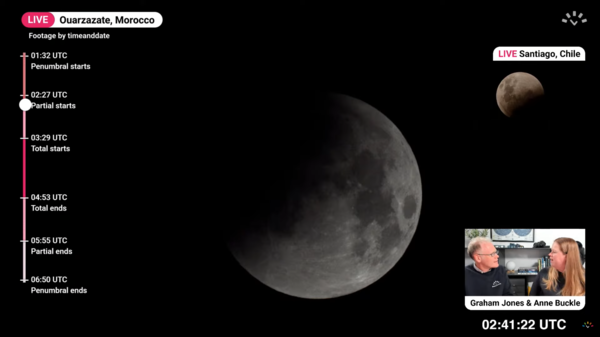Getting Ready for a Lunar Eclipse Live Show
Our mobile observatory team is preparing to live stream the November 2022 lunar eclipse. Meanwhile, our partners around the world will provide contrasting views of the same event.

At the end of last month, our mobile observatory was streaming a partial solar eclipse from the northern tip of Norway. Now it’s heading off to the desert of New Mexico to capture a total lunar eclipse.
Live from across the Globe on timeanddate
timeanddate’s fourth and final live stream of 2022 will be the total lunar eclipse on November 7–8.
Watch the eclipse LIVE on timeanddate
Our mobile observatory is heading to the desert of New Mexico, in the Southwestern United States. We’re planning to set up our telescopes on a rooftop in the world-famous city of Roswell, where we’re getting on-the-ground support from the Roswell Astronomy Club.
We’re also collaborating with our network of streaming partners across the globe.
- The San Diego Astronomy Association will be sending us a live telescope feed from the hills of Southern California.
- We’ll have live images from New York City, courtesy of the Amateur Astronomers Association.
- The Subaru-Asahi Star Camera will capture the eclipsed Moon from the top of Maunakea in Hawaii.
- The Starry Knights astronomy-outreach team will provide a second feed from the Aloha State.
- A group at Perth Observatory will film the eclipse from Western Australia.
A Complex Operation

The timeanddate control room is a hive of activity during an eclipse live stream.
©timeanddate
Meanwhile, at the timeanddate HQ in Stavanger, Norway, we’re getting ready to pull everything together and produce a four-hour show that includes live commentary, interviews, and on-screen information.
It’s a complex operation that involves careful planning of travel arrangements for our mobile observatory—including backup scenarios in the event of bad weather. It also involves close coordination and teamwork with our collaborators around the world.
Different Views of the Same Event
One of the fascinating things about having multiple feeds of the eclipse is being able to compare views from various parts of the globe.
In fact, this is one of the most popular questions we get asked during our live shows: why does the eclipse look different from different locations?

In this screenshot from our May 2022 live stream, the partially eclipsed Moon appears the opposite way around when seen from two locations.
©timeanddate
A lunar eclipse takes place hundreds of thousands of miles away, as the Moon passes through the Earth’s shadow in space.
Clouds permitting, the eclipse is visible from anywhere on the night-time side of the Earth. The various stages of the eclipse—for example, the start of totality—happen at the same time for everyone. But in our live shows, the position of the Earth’s shadow on the face of the Moon can look very different from one feed to the next.
One reason is that the equipment used to film the Moon is not the same. Telescopes can flip images top to bottom, left to right, or a combination of both these things.
Northern versus Southern Hemisphere
Even with the naked eye, however, the eclipse can appear another way around for different observers.
There are two explanations for this. The first is to do with the Northern and Southern Hemispheres. An observer in one hemisphere sees the Moon ‘upside down’ as compared to an observer in the other hemisphere.
Moonrise versus Moonset
The second explanation is to do with the observer’s local time. For some people, a lunar eclipse happens in the early hours of the morning, close to the time the Full Moon sets. For others, the eclipse happens in the evening, close to the time the Full Moon rises.

This image from our eclipse animation for New York shows how the Earth’s shadow will appear on the Moon at 04:53 (4:53 am) local time—around two hours before moonset ...
©timeanddate

... Meanwhile, at the same moment, this is how the shadow will appear as seen from Beijing, which is about the same distance north of the equator. The local time here is 17:53 (5:53 pm)—roughly one hour after moonrise.
©timeanddate
An observer’s local time affects their view of the eclipse because the Moon appears to rotate as it passes overhead between moonrise and moonset.
It’s not really the Moon that rotates—it’s actually the observer who rotates as the Earth spins.
Imagine that the Moon’s movement across the sky was sped up: we can see the Moon rise above the eastern horizon, but we have to turn around (in other words, rotate) to watch the Moon set beneath the western horizon.
It’s possible to see this rotation over the course of a night on our Night Sky Map. For example, click here to see December’s Full Moon rise and set (use the play button, or drag the progress bar to the right).
Join Us
You can join us and our streaming partners to watch the eclipse online from 09:00 UTC on Tuesday, November 8.
Watch the eclipse LIVE on timeanddate
And if you’re in North America or Australia—or in parts of Asia, South America, or Europe—you can head outside to watch the eclipse happening overhead. We wish everyone clear skies!